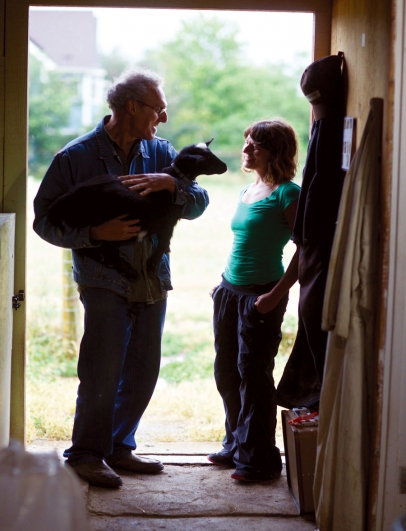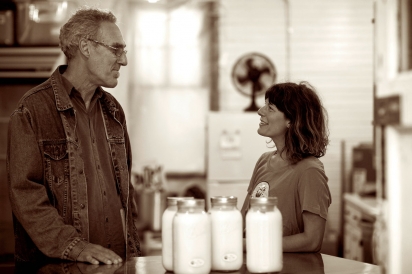Building the Soil of a Restorative Economy
A Conversation with Slow Money Visionary Woody Tasch
Woody Tasch has been working with food and finance for decades. As an economist in the late 1970s he worked on a project at the International Maize and Wheat Improvement Center in El Batan, Mexico, home of the initiatives that increased global food production, somewhat inaptly referred to as the “Green Revolution.” He then spent the 1980s in the venture capital world in New York City.
“Here I am 30 years later on the exact opposite end of a big arc of understanding,” says Tasch. He views his work today as antithetical to both venture capital and “the big, industrial, technologically driven, monocultural approach to food production” accelerated by the Green Revolution.
In the 1990s, Tasch was treasurer of the Jessie Smith Noyes Foundation, an environmental fund, and in 1998 became chairman of Investors’ Circle, a nonprofit network of angel investors and venture capitalists dedicated to sustainability.
In 2007 he took a sabbatical to write what would become Inquiries into the Nature of Slow Money, a book that provided groundwork for the Slow Money organization, which has since been lauded as a “movement,” a “revolution” and identified as a top trend in both finance (Entrepreneur.com) and organics (Rodale).
The first Slow Money principle, “We must bring money down to earth,” hints at Tasch’s love of wordplay, and his insistence on bringing poetry and humor into the conversation. “Those of us who are trying to self-organize around a new way of investing need new, more poetic ways of thinking and speaking about how we are trying to use our capital,” he writes.
Half a decade in, Slow Money has sprouted 3,300 supporters, some two dozen local networks, 10 investment clubs and has raised $35 million that has been invested in 300 small food enterprises across the US and Europe.
Edible Front Range’s Bill Giebler recently sat with Tasch in his home office in the hills above Boulder, CO.
* * *
Bill Giebler: Why food? Do the principles of Slow Money apply to other things?
Woody Tasch: People often ask, “Why aren’t you talking about renewable energy or community health care or independent media?” The same general ideas could apply.
To me, the vision of Slow Money is so tied to Slow Food. I’d started talking about what I called “Patient Capital” inside Investor’s Circle. In 2000 I was lucky enough to go to Italy and meet all the Slow Food people. I realized, “Oh my god, Patient Capital is really Slow Money.” Food is so fundamental to moving toward a restorative economy and it’s a good way to engage people because it’s tangible and direct.
BG: There’s a discord in environmental thinking between technological over-dependency on one end and Luddite regression on the other. Where do you fall on this spectrum?
WT: I am very concerned about the excesses of technology and an over-reliance on technological fixes. We do need to work on all cylinders on every new technology we can think of; I’m not against that. But I’m against thinking that’s all we need. I’m against all of our time, money and consciousness saying we need 5,000-acre farms producing two varieties of things to get to market as shelf-stably and cheaply as possible.
From a cultural and biological point of view I think the idea that we could do without small intensive farms and just rely on big industrial farms is crazy for about 10 different reasons: biodiversity, soil erosion, water quality; and then the cultural things that happen when you’re producing food as cheaply as possible, like hollowing out of rural towns.
People say, “You can’t feed the world with all those little farms, you need the big ones.” But this is a completely myopic response to a very nuanced problem.
First, only 20%-25% of grain goes to feed humans directly. The rest goes to livestock or cars.
Second, only about 60% of the food we produce that is for human consumption actually gets into someone’s mouth versus going to a compost pile or dump. So, the system we have that’s efficient at using dollars to produce food isn’t actually that efficient at utilizing land and water to feed people.
Third, the dietary regime we have slid into over the last 50 or 75 years has obvious limitations. There’s a consensus estimate that a third of Americans are going to have diabetes by 2050. We already know the obesity statistics. This is coming from a highly processed industrialized food system stupendously effective at producing cheap, shelf-stable calories and producing foods with lots of grease and salt and sugar. Changing the way we eat isn’t a bad thing.
Then people say “It’s elitist and costs more.” The elitist part is really about a system that has externalized the long-term social and environmental costs of producing cheap food, and now these costs—in terms of soil erosion, obesity, carbon in the atmosphere and inhumane treatment of animals—are starting to come home to roost.
BG: Let’s talk about fast money. The admonition of “bigger is better” is familiar at this point. How does speed play in? WT: There’s scale and speed, and then there’s local and global. So slow, small and local are three nested things that all raise questions about fast, big and global. E.F. Schumacher, who wrote Small is Beautiful in 1973, famously said if everything were small he’d be arguing in favor of big. We need both. It’s a matter of balance and we’re in this very unbalanced mode with the idea that solutions and financial institutions and markets and corporations should be big.
After what’s happened in the last Ave years in the financial markets, it’s obvious that financial institutions that are too big are bad. They’re bad because they’re prone to collapse, they’re too difficult to regulate, there’s too much opportunity for greed.
BG: In Slow Money you write about nonviolence and of “borrowing from the planet, stealing from future generations.” Is that a form of violence?
WT: I think it is. There’s overt violence and then there’s implicit violence. A farmer pouring tons of chemicals on his crops does not think of it as violence. I think it’s a form of inadvertent violence. As we look at doing no harm, there are few things we can do that cause as little harm as supporting our local organic farmer.
BG: If we’re stealing the fertility of the soil from the future, isn’t that violence?
WT: That might be debated by some proponents of industrial agriculture, but here’s something that can’t be debated: We’re depleting the Ogallala aquifer. We’re pumping water out of there to support the irrigated monocultures in the Midwest at a much faster rate than it can replenish naturally. There’s no debate about it. So, sometime in the next 50-100 years there is going to be a major problem there. Is that a form of violence? Then there’s carbon in the atmosphere. Agriculture contributes a significant amount of greenhouse gases in a bunch of different ways.
Trying to opt more for balance and slowing down that industrial agricultural machine a little bit to divert some resources to small-scale organics, to me, is an obvious good.
BG: Does Slow Money essentially bring the concept of voting with our dollars from the consumer realm to the investor realm?
WT: Let’s talk about CSAs [community-supported agriculture subscription programs, where a customer pays the farmer up front for a weekly share of their farm products]. Is a CSA an investment or a purchase decision? It’s both. You’re giving the farmer money, it’s kind of a loan, but you’re not charging interest. You’re giving money in advance and you’re going to get your food back over time. And there’s risk, so it’s a form of investment.
I sometimes refer to Slow Money as the CSA of investing. It’s a very relationship-based form of investing that has a whole bunch of qualitative things inextricably woven into it. If we want farms to be in our communities, how do we think they’re going to be there? We can be their customer. Great. We can think we’re paying more or assuming more risk to be their customer. Great. We do it because there’s value: We want the farm to be there. But if you take it just one tiny step further, you see that these enterprises are small businesses, they need financing, they need more than just consumer dollars; they need capital. And if I really care about them, why am I leaving my capital somewhere where it might even be invested in something diametrically opposed to what they’re trying to do?
BG: Why do we want small farms in our communities?
WT: I was speaking at a wealth management conference about two years ago in Chicago, to 50 ultra-high-net-worth families a major bank had pulled together, and they had a panel on impact investing. When it got to me I asked—trying to be as provocative as I could—”How many people think their health, the environment and the country as a whole would be better off if there were a million new small or mid-size organic farms in the country?” Half the people in the room raised their hand. It really did blow my mind.
The experience of Slow Money over the last few years suggests there are a bunch of people out there—we’re up to $35 million and thousands of people!—who care. I’m quite convinced there are millions of Americans who share these concerns.
What’s the quickest route to the most solutions? Government regulation of the financial institutions? A fair and just farm bill? Perfectly legitimate wonderful things to work on. They’re all, to me, very indirect, very constrained by major institutional and cultural roadblocks. I’d rather invest in an entrepreneur than lobby a politician.
BG: Can you give me some examples of Slow Money at work around the country?
WT: Investments range from decent-sized angel investments— some in the millions—all the way to lots of very small loans, with a few individuals teaming up to lend a few thousand dollars to a farmer. For instance, loans were provided for Maine Grains, an organic grain mill, and Point Reyes Compost, a California composting operation attached to a family organic dairy. In North Carolina 16 people collaborated to refinance Chatham Market, a local food co-op, and a small loan helped Field Day Family Farm in Louisville, Kentucky, buy two new greenhouses. Locally, we’ve provided loans to a sauerkraut company, a goat dairy and a company that’s installing backyard vegetable gardens in the suburbs (see sidebar).
BG: You write a lot about playfulness, humor, beauty. Tell me how that plays into Slow Money.
WT: The playfulness is my intellectual, emotional, spiritual and psychological defense against the reductionism, the lowest-common-denominator-ism, the economy stupid-ism of the time we live in where everything is all about money and economics and growth. I’m just trying to push back.
BG: My observation reading Slow Money was that rather than seeking to create a new economics you’re seeking to create a language from which a new economics can emerge.
WT: A lot of people who are worried about where we are as a civilization and a species or a planet talk about a new narrative, a new story, a new way of thinking about big cultural matters. The linguistics is basically a clue to saying we need to come up with a new story. So whether or not all the words are exactly right, they’re just playful words on the way to a new story.
I think it’s way too much pressure to put—certainly on me, certainly on Slow Money as an organization and certainly on a million or two people who want to move in a new direction—to say “you have to have a whole new system, a whole new economic idea figured out before we’ll admit there’s validity to it.” It’s a direction, a conversation, a process of personal and cultural change that is highly imperfect and not always quantified, and that’s why the attention to words and stories is really important.
BG: Is it too early to talk about the next book?
WT: Pretty much from day two everyone wanted a how-to thing. I went through that cycle and came out the other side. For the how-to, we’re launching our first state of the sector report and we’re putting on our first master class this year in Louisville (Kentucky)—a day and a half training session that goes from “What is Slow Money?” down to “How do you do due diligence on a deal?” and “What’s a promissory note?” So it’s not like we don’t pay attention to all that stuff. But my interest as a writer is not in producing a manual.
Wendell Berry talks about how we need a new kind of imagination to re-imagine our relationship to nature. We’re about having a new story, a new way of understanding what we’re supposed to do. Wealth is just one of the tools we have to do it with. The technical issues of debt, equity, due diligence, philanthropy clubs, funds, crowd funding, certifications, are all technical aspects we have to deal with in doing this new thing. But we’re still at the stage where we have to affirm deeply why we need to do it, the direction we need to go in and what the long-term destination is. So Slow Money, the first book, was my attempt to say some of this out loud. Now that we have the experience of the last five or six years, I can return and take another look at it.
I’ve come to be enamored with the concept of biophilia, which was articulated by E.O. Wilson, the renowned conservation biologist. He defines biophilia as the innate affection humans have for all other living things. So I sometimes think of the narrative of what we’re trying to do in Slow Money as awakening biophilia in the heart and mind of the 21st century investor. Can we connect our economic selves to life on the planet in a really radical and possibly even beautiful way?
Taking Local National
This year is Slow Money’s fifth national gathering will be held in Louisville, KY, November 10-12. It will feature workshops, showcases of exemplary small food enterprises from around the country and “some of the leading thought leaders in food and finance,” says Tasch. Like internationally acclaimed activist Vandana Shiva, renegade farmer and author Joel Salatin, author and distinguished environmental studies professor David Orr and leading social investment expert Amy Domini, one of Time Magazine’s “100 most influential people in the world,” to name a few. Learn more and register at SlowMoney.org.
Frequent Edible Front Range contributor Bill Giebler’s award-winning work is featured in The Best Travel Writing, Volume 10 (Travelers’ Tales Sept 2014). His work on food, sustainability, health and travel has appeared in Organic Spa Magazine, Green Living Journal, Warren Miller’s SnoWorld and on GaiamLife and MSN.





